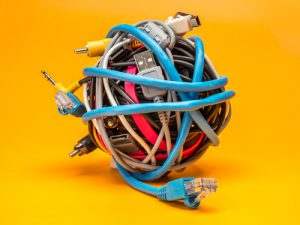Share This
Related Posts
Tags
Cable Free Cometh
By Anca Gagiuc on Mar 27, 2019 in Technology
Charging cables, while a necessity, are something we’d like to never have to use again. That means batteries too. Battery technology, despite the increasing need in the auto industry, is only slowly advancing, but the results show potential.
Researchers have been investing resources into annihilating cables; not long ago researchers from the University of Washington presented a system they named Power over Wi-Fi (PoWiFi). More recently, scientists from MIT and the Technical University of Madrid are looking into a new way of converting energy from Wi-Fi signals into electricity that could power electronics.
Their latest study involves a new kind of rectenna: a device that converts alternative current electromagnetic waves into direct current (DC) electricity. The rectenna uses a flexible radio-frequency antenna which captures electromagnetic waves, including those carrying Wi-Fi, as alternative current (AC) waveforms.
This antenna is then connected to a novel device called rectifier, for which the researchers used a two-dimensional semiconductor just three atoms thick (called molybdenum disulfide—MoS2), one of the thinnest semiconductors in the world. The AC signal travels into the semiconductor, which converts it into a DC voltage that can be used to power electronic circuits or recharge batteries. In short, this battery-free device passively captures and transforms ubiquitous Wi-Fi signals into useful DC power. Furthermore, the device is flexible and can be set up to cover very large areas.
“What if we could develop electronic systems that we wrap around a bridge or cover an entire highway, or the walls of our office and bring electronic intelligence to everything around us? How do you provide energy for those electronics?” asked Tomás Palacios, a professor in the Department of Electrical Engineering and Computer Science & director of the MIT/MTL Center for Graphene Devices and 2D Systems in the Microsystems Technology Laboratories. “We have come up with a new way to power the electronics systems of the future—by harvesting Wi-Fi energy in a way that’s easily integrated in large areas—to bring intelligence to every object around us.”
This new rectenna could be used to power flexible and wearable electronics, medical devices and sensors for the Internet of Things. The timing is especially good for major tech firms as currently the smartphone industry is betting big on flexible devices. In the researchers’ experiments, the new device can produce about 40 microwatts of power when exposed to the typical power levels of Wi-Fi signals (around 150 microwatts), more than enough to light up a LED or drive silicon chips.
The rectenna’s flexibility comes with new perks: it can be deployed over large areas (think wallpaper), but also in small, portable devices such as the above-mentioned flexible smartphones. Another field of activity would be medicine as the technology could be applied in medical implants and swallowable sensors—these gizmos need power too but using batteries would be risky as they can leak lithium and that could turn deadly for the patient. “It is much better to harvest energy from the environment to power up these small labs inside the body and communicate data to external computers,” said Jesús Grajal, a researcher at the Technical University of Madrid.
The new rectennas feature more promising properties, among which is the reduction in parasitic capacitance—the tendency of materials in electrical circuits to act like capacitors, storing a certain amount of charge. In AC electronics, this can limit the speed of signal converters and their ability to respond to high frequencies. While this new kind of rectenna also has parasitic capacitance, it is below the magnitude of those developed so far, and this enables the device to capture signals up to 10GHz, including in the range of typical Wi-Fi devices.
“Such a design has allowed a fully flexible device that is fast enough to cover most of the radio-frequency bands used by our daily electronics, including Wi-Fi, Bluetooth, cellular LTE, and many others,” said EECS postdoc Xu Zhang.
The maximum output efficiency for this device stands at 40 percent, depending on the input power of the Wi-Fi input. At the typical Wi-Fi power level, the power efficiency of the rectifier is about 30 percent. For reference, today’s rectennas made from rigid (and more expensive) silicon or gallium arsenide achieve around 50 to 60 percent.
“This very nice teamwork from MIT demonstrates the first real application [of] atomically thin semiconductors for a flexible rectenna for energy harvesting,” said Philip Kim, a professor of physics and applied physics at Harvard University whose research focuses on 2D materials. “I am amazed by the innovative approach that the team has set up to utilize the waste energy from RF power around us.”
So far, the paper has 15 co-authors from MIT, Technical University of Madrid, the Army Research Laboratory, Charles III University of Madrid, Boston University and the University of Southern California. The team plans to improve efficiency and build more complex systems.
